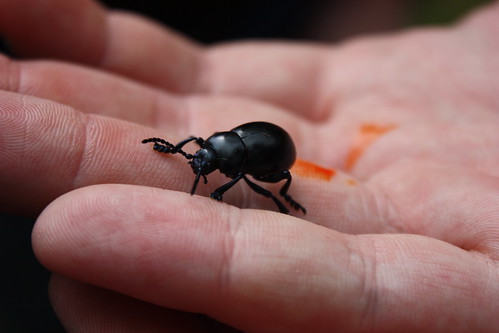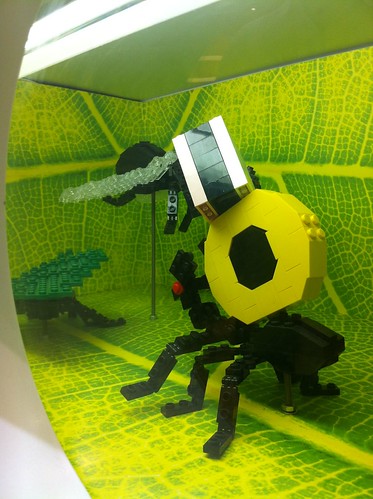Notes from my experience breeding and studying a wide variety of different invertebrates.
Wednesday, 25 May 2011
Monday, 23 May 2011
Identification key to the European genera of bees
As a bit of house-keeping I have just moved this website from the old ICZN (= NHM hosted sites) server and into a Scratchpad. It can now be found at: http://alarm.myspeecies.info.
In the News: Making art is a bug’s life
From the Norwich Evening News: Making art is a bug’s life
Close up, out of context, they look like highly decorative pieces of jewellery. Except these sparkling pieces of gold, pearl and gem stones aren’t the work of a jeweller, rather they have been produced by a particularly industrious insect who will draw on whatever it finds to create a cocoon.
Caddis fly larvae are known to incorporate bits of whatever they can find into their cocoons, be it fish bone or bits of leaves. However when placed in a tank with flakes of gold and gemstones, the caddis flies simply create their protective sheaths from these materials instead.
More links:
- Pestival: Caddis Fly Sculptures
- Cabinet Magazine: Artist Project / Trichopterae
- Leonardo Online (author interview): The Wonderful Caddis Worm: Sculptural Work in Collaboration with Trichoptera
Thursday, 19 May 2011
Beetle Queen Conquers Tokyo
This looks like a must-see film: Beetle Queen Conquers Tokyo (it's a documentary). I think I'll order myself a copy......
Wednesday, 18 May 2011
Chronophage Clock
Clock built using a grasshopper escapement on display at the Science Museum. The "demonic" creature on the top represents a time-eating grasshopper.
Originally posted at Cabinet of Orthopteroid Curiosities: The Midsummer Chronophage where there are also links to other information about the clock.
Tuesday, 17 May 2011
Bloody-nosed Beetle (Timarcha tenebricosa)
As part of the eMonocot project's outreach activities Paul Wilkin (Kew), Ian Kitching (NHM) and I led two monocot walks as part of the Lyme Regis Fossil Festival.
As well as finding around 30 different monocot species in the undercliffs, there were a few invertebrate finds as well.
The bloody-nosed beetle is a large (for the UK) chrysomelid beetle that can often be seen walking rather clumsily along the ground. When disturbed it puts of potential predators by exuding a bright red/orange secretion from its mouthparts (seen here staining my hand).
Labels:
beetle,
emonocot,
fossil festival,
ian kitching,
lyme regis,
paul wilkin
In the News: How a book about flies cost $23.7 million on Amazon
From Digital Life on Today: How a book about flies cost $23.7 million on Amazon
If you were shopping for a new copy of Peter Lawrence’s The Making of a Fly — a classic work on developmental biology — on Amazon recently, you might've gotten quite a shock. The book was priced at $23,698,655.93 (plus $3.99 shipping)! What happened?
Michael Eisen, an evolutionary biologist at UC Berkeley, first noticed the strangely high book price.
Read more
Monday, 16 May 2011
In the News: Bryozoans may look like coral but the similarities end there
During the recent marine debris conference in Honolulu, I overheard an artist explain to a student that coral grew on drifting plastic. The piece they were examining had a splotch of cementlike growth stuck to it. That white stuff, however, was not coral.
"Those are bryozoans," I said.
As soon as I said it, I wished I hadn't because the artist, of course, said, "What's a bryozoan?" And I didn't have a good answer.
Even as I write, with three zoology textbooks, a field guide and the Internet in front of me, I'm still struggling with how to describe the little creatures called bryozoans.
Part of the problem in describing these animals is the variety of forms and lifestyles they take. Bryozoans can be upright and branching, thin and encrusting, lacy and fragile, tangled and bushy. A few bryozoans walk on sand using rowing movements of whiplike appendages. A freshwater, jellylike species creeps over plants like a snail.
Read more
"And God Was A Fly"
Surreal artwork by Joe MacGown
See on the artist's site: "And God was a Fly"
Maybe we have it all wrong, perhaps the great mother is a fly. why do we always consider ourselves to be the dominant species anyway?
See on the artist's site: "And God was a Fly"
In the News: Wasp hounds to beat bed bugs
From ajc: Georgia scientists prove wasps best bed bugs
Toothpaste? Check.
Pajamas? Check
Wasps? Say what?
Two South Georgia scientists have invented the Wasp Hound, a carry-along bedbug detector that relies on stinger-less wasps to determine whether the malicious mites have infested a hotel’s beds, pillows or sheets. All they need is $500,000 to bring the Wasp Hound to market.
Read more
In the News: U.S. states braced for invasion of cicadas as they hatch after 13 years underground
From The Daily Mail: U.S. states braced for invasion of cicadas as they hatch after 13 years underground
Their haunting chirrup strikes fear into the heart of every gardener.
For thirteen years this cicada hoard has lain dormant in its underground lair, awaiting the right time to strike. And it appears that that time has come.
Even at this very moment, billions of the winged insect are crawling from their exoskeleton cages, ready to suck the sap out of every plant, tree and bush that gets in their way....
Read More
Thursday, 12 May 2011
Pretty Orthopteroid Pictures
More random orthopteroid/polyneoptera stuff at: Cabinet of Orthopteroid Curiosities.
Links to scientifically useful Orthopteroid Internet Resources.
Entomophagy: Ants
From globalpost: In northern Colombia, a hunt for gourmet big-butt ants
IBA, Colombia — Emerging from the soil this time of year is something Colombian farmers covet more than anything they can grow: big-butt ants.
Known in Spanish as "hormigas culonas," the brown, cockroach-size insects are roasted, salted and eaten like peanuts. Considered a delicacy, they can fetch more than 10 times the price per pound of Colombia’s world-famous coffee.
In northern Santander department, about the only place in Colombia where they flourish, the ants are sometimes used as pizza topping. One enthusiastic chef serves beef tenderloin and pork cutlets drizzled in ant sauce.
The notion of eating ants may trigger the gag reflex so first-timers are advised to instead focus on their earthy, nutty taste and day-old-popcorn texture.
“The more you eat, the more you want to eat,” said farmer Miguel Angel Paez, 25, who has been gathering ants since he was a boy. “The butt is the best part.”Read more
Wednesday, 11 May 2011
Fruit flies 'swim' through the air
From physicsworld.com: Fruit flies 'swim' through the air
"Physicists studying the flight of the fruit fly have concluded that the tiny creature's wing motions are much closer to the movement of swimming organisms than previously thought. This surprising result lends credence to the controversial suggestion put forward by some evolutionary biologists that flight could have evolved gradually from swimming as life left the oceans.
The wings of birds and insects are structurally quite similar to the fins and paddles of aquatic animals. However, flying and swimming seem to involve completely different physical processes. Flying organisms propel themselves using the lift forces generated as a wing slices through the air, while swimming organisms paddle forward using the viscous drag of water. As a result, some biologists have doubted that flight could have evolved from swimming."Read more
Tuesday, 10 May 2011
Subscribe to:
Posts (Atom)
ShareThis
Copyright Ed Baker















